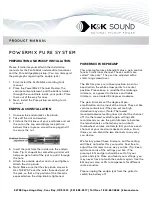
G P I B / I E E E 4 8 8 . 2 R E M O T E O P E R A T I O N
ANSI/IEEE-488.2 Definitions
24
OMM-6810B
C H A P T E R
3
ANSI/IEEE-488.2 Definitions
The following sections contain the relevant definitions for syntax diagrams and
syntax elements for the GPIB commands, as defined by the IEEE-488.2 standard.
Syntax Diagrams
Syntax diagrams indicate the most complete form of GPIB command construction.
The terminology shown here and in subsequent sections is used throughout this
manual to define the command syntax. These syntax diagrams conform to the
ANSI/IEEE-488.2-1987 standard, and the terminology presented here reflects that
standard.
The oval (or round) shape contains a terminal syntactic
element. These represent a basic function such as a single
ASCII character, which cannot be divided.
Rectangles contain non-terminal syntactic elements. These
represent elements which are expandable to a diagram of
terminal syntactic elements. However, they are presented as
a unit for clarity or emphasis.
Lines and arrows indicate correct paths through the syntax
diagram. A reverse line around an element indicates that the
element may be repated indefinately. A forward arrow
around an element indicates that the element is optional.
<white space>
White space is defined by the syntactic diagram shown in Figure 3.1, where
<white space character> is defined as a single ASCII-encoded byte in the range
00-09, 0B-20 (0-9, 11-32 decimal). This range includes the ASCII control
characters, carriage return, and the space, but excludes the new line character.
In most practical programming situations, the space character (space bar) would
be used as white space. White space is generally used to separate syntactic
elements and is processed without interpretation.
















































